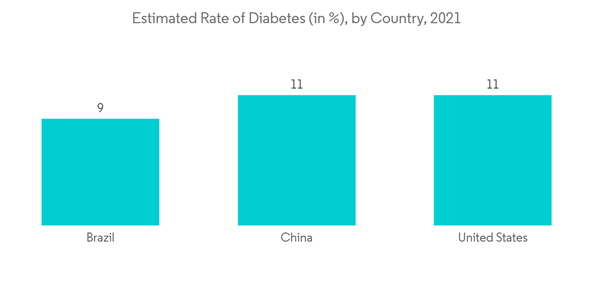The COVID-19 outbreak impacted the wound care management market. It affected the global economy and greatly impacted the functioning of general hospital care for non-COVID-19 patients in hospitals. For instance, according to the NCBI research article published in September 2021, a significant percentage of patients with chronic wounds delayed preventative and emergent wound care during the pandemic. In addition, during the pandemic, huge importance was placed on wound care to prevent serious wound complications by minimizing hospitalizations and surgeries. For instance, an article published by UpToDate Inc. in June 2022 stated that the delivery of wound care, which should be regarded as an essential medical service, shifted during the COVID-19 pandemic. Thus, the low availability of wound care management services during the pandemic adversely impacted the market. However, with a decrease in COVID-19 cases and the resumption of healthcare services, the market has started to gain traction and is expected to continue the upward trend over the forecast period.
The increasing incidences of chronic wounds, ulcers, and diabetic ulcers, the rising volume of surgical procedures worldwide, and the increasing product advancements are the major factors propelling the market's growth. Diabetes is a major wound-causing disease, along with other chronic diseases. The incidence of chronic wounds, especially foot ulcers, is increasing among the diabetic population. As per the International Diabetes Federation (IDF) report 2021, there were around 537.0 million people with diabetes worldwide. The same report suggested that the number of people with diabetes is increasing drastically every year, contributing to the high incidence of diabetic ulcers. With rising cases of ulcers, the demand for wound care management is expected to rise, thus contributing to the market's growth over the forecast period.
The increasing geriatric population is also propelling the demand for wound care management. For instance, as per Germany Federal Statistical Office 2021 report, there were about 83.0 million people in Germany, of which 16.2 million people were above 67 years of age. This number is projected to reach 21.4 million by 2040. Since the elderly population is more prone to chronic diseases like diabetes and diabetic foot ulcers, the increasing geriatric population is anticipated to surge the market's growth. With an increasing number of older people across major countries, the need for wound management related to diabetes and other chronic conditions is expected to increase. Thus, considerable market growth is expected over the forecast period.
However, the lack of reimbursement policies and high treatment costs may hinder the market's growth over the forecast period.
Wound Care Management Market Trends
Diabetic Foot Ulcer Segment is Expected to Witness Considerable Growth During the Forecast Period
A diabetic foot ulcer commonly occurs on the sole of diabetic patients. The increasing number of cases of diabetic foot ulcers is one of the major factors propelling the segment's growth. For instance, according to the 2021 data published by the University of Michigan Health, ulcer usually affects around 15.0% of the diabetic population. Diabetic foot ulcers can cause hospitalization in about 6.0% of the affected diabetic patients. The large number of people affected by diabetes across the world and the associated foot ulcers may increase the need for proper wound care management, which is expected to boost the segment's growth over the forecast period.According to a research article published in the Journal of Foot in February 2022, nearly 67.0% of leg amputations in the United States were associated with diabetes. Several initiatives are being taken by the governments of major countries to tackle diabetic foot ulcers, which are adding to the growth of the segment. For instance, in July 2021, six research institutions from the North American region, funded by the National Institute of Health, launched the first-ever multicenter network to study diabetic foot ulcers, a common and burdensome complication of diabetes and the leading cause of lower-limb amputations. The Diabetic Foot Consortium (DFC) focuses on establishing the foundation for a clinical trial network to test how to improve diabetic wound healing and prevent amputations among the 27 million American adults with diabetes. The DFC is supported by the NIH's National Institute of Diabetes and Digestive and Kidney Diseases (NIDDK).
Thus, owing to such favorable initiatives and increasing cases of diabetic foot ulcers, the segment is expected to show significant growth over the forecast period.
North America is Expected to Witness Significant Growth During the Forecast Period
North America is expected to witness significant growth over the forecast period. The growth is due to the rising number of chronic diseases and associated wounds and ulcers. The rising cases of chronic wounds and the necessity to properly manage the pain and comorbidities associated with wounds and ulcers are expected to propel the growth of the market over the forecast period. For instance, according to the International Diabetes Federation Diabetes Atlas Tenth Edition, in 2021, around 32.2 million people in the United States had diabetes, which are projected to grow to 36.3 million by 2045. The rising number of diabetic cases in the region is expected to increase the number of diabetic ulcer cases and contribute to the market's growth in the region.Key product launches, high concentration of market players or manufacturers, acquisitions and partnerships among major players, and increasing cases of chronic wounds in the United States are some of the factors driving the growth of the US wound care management market. For instance, as per the research article published in the Journal Foot and Ankle Research in June 2021, rural Americans with diabetic foot ulcers had a 50.0% risk of major amputation compared to their urban counterparts. The need for proper wound care management in the rural regions of the United States is expected to add to the market's growth over the forecast period. Similarly, a large portion of the US population is affected by chronic diseases, which are the most common causes of chronic wounds. For instance, a March 2021 article published in the Journal of Advances in Wound Care indicated that chronic wounds impact the quality of life (QoL) of nearly 2.5% of the US population.
Therefore, the rising number of people affected by chronic wounds, ulcers, and diabetic ulcers is expected to boost the growth of the US wound care management market over the forecast period.
Wound Care Management Industry Overview
The wound care management market is competitive and consists of several major players. The market players are committed to developing innovative healing solutions for customers and patients across the care continuum, generating proven clinical outcomes. The companies are also showing continuous growth and developing new and differentiated products and services, which address the evolving healthcare needs of patients, providers, and consumers. Some of the companies currently dominating the market are 3M Company, B. Braun SE, Cardinal Health, Inc., Coloplast AS, Johnson & Johnson, ConvaTec Group PLC, Integra Lifesciences, Molnlycke Health Care, Medtronic PLC, Paul Hartmann AG, and Smith & Nephew.Additional Benefits:
- The market estimate (ME) sheet in Excel format
- 3 months of analyst support
This product will be delivered within 2 business days.
Table of Contents
Companies Mentioned (Partial List)
A selection of companies mentioned in this report includes, but is not limited to:
- 3M Company
- B. Braun SE
- Cardinal Health Inc.
- Coloplast AS
- ConvaTec Group PLC
- Integra Lifesciences
- Molnlycke Health Care
- Medtronic PLC
- Paul Hartmann AG
- Smith & Nephew
Methodology

LOADING...










